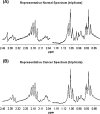Deriving biomedical diagnostics from NMR spectroscopic data
- PMID: 28510234
- PMCID: PMC5418393
- DOI: 10.1007/s12551-011-0045-8
Deriving biomedical diagnostics from NMR spectroscopic data
Abstract
Biomedical spectroscopic experiments generate large volumes of data. For accurate, robust diagnostic tools the data must be analyzed for only a few characteristic observations per subject, and a large number of subjects must be studied. We describe here two of the current data analytic approaches applied to this problem: SIMCA (principal component analysis, partial least squares), and the statistical classification strategy (SCS). We demonstrate the application of the SCS by three examples of its use in analyzing 1H NMR spectra: screening for colon cancer, characterization of thyroid cancer, and distinguishing cancer from cholangitis in the biliary tract.
Keywords: 1H NMR spectra; Biomedical spectroscopy; Cancer screening; Soft independent modelling of class analogies (SIMCA); Statistical classification strategy (SCS).
Figures



References
-
- Albiin N, Smith ICP, Arnelo V, Lindberg B, Berquist A, Dolenko B, Bryksina N, Bezabeh T. A detection of cholangiocarcinoma with magnetic resonance spectroscopy of bile in patients with and without primary sclerosing cholangitis. Acta Radiol. 2008;49:855–862. doi: 10.1080/02841850802220092. - DOI - PubMed
-
- Duda RO, Hart PE, Stork DG. Pattern classification. 2. New York: Wiley-Interscience; 2001.
-
- Eriksson L, Johansson E, Kettaneh-Wold N, Wold S (2001) Multi- and megavariate data analysis—principles and applications. Umetrics, Umea
-
- Hastie T, Tibshirani R, Friedman J (2009) The elements of statistical learning: data mining, inference and prediction, 2nd edn. Springer, Berlin
Publication types
LinkOut - more resources
Full Text Sources

